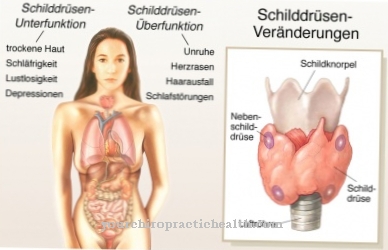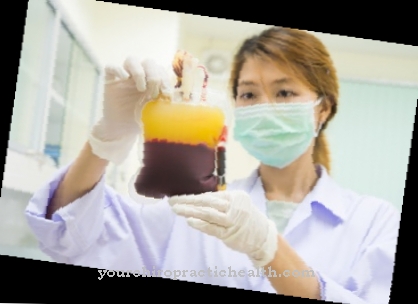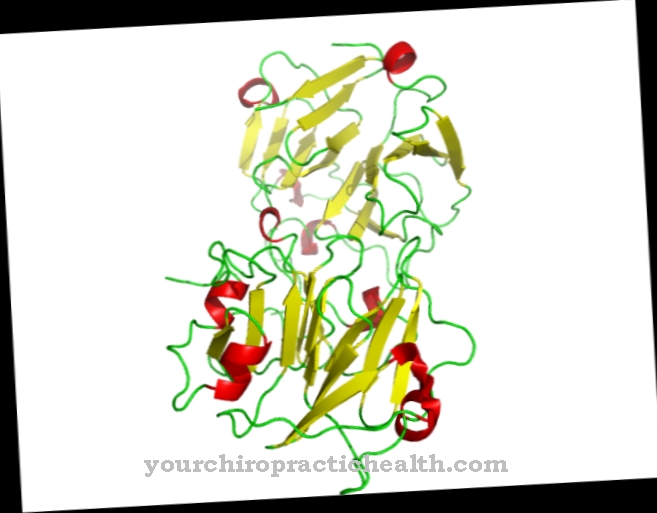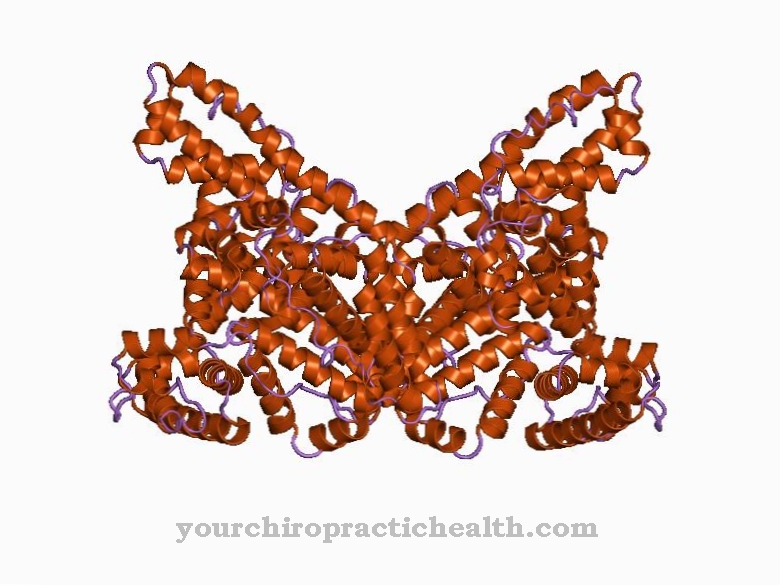Zeaxanthin is an orange-yellow dye that occurs naturally in plants and animals. In humans, zeaxanthin is found in the retina. It has antioxidant properties and, according to the current state of knowledge, plays a role in connection with macular degeneration.
What is zeaxanthin?
Zeaxanthin is a dye that appears orange-yellow and belongs to the group of xanthophylls. Medicine in turn subordinates these to the carotenoids. In its pure form, zeaxanthin forms crystals that shine steel blue.
Zeaxanthin is in a solid state and melts at 215 ° C. It is almost insoluble in water, but in fat. The substance is also known as all-trans-β-carotene-3,3'-diol; this term refers to the exact (bio) chemical properties of the zeaxanthin. It can also be found under the E161h label as a food coloring. In the EU, the color is approved as an additive. Of course, the chemical compound occurs, among other things, in corn kernels, which it gives its characteristic color. The molecular structure of zeaxanthin is composed exclusively of carbon, hydrogen and oxygen. Its molecular formula is C40H56O2.
Function, effect & tasks
Zeaxanthin forms a pigment in the lens of the eye and the retina. The light-sensitive cells that convert optical stimuli into nerve impulses are located in the retina. In the middle of the retina is the yellow spot (macula lutea).
Together with another carotenoid, lutein, zeaxanthin causes the yellow spot to color, which gives you its name. The pigments prevent too much light from falling on the retina to a certain extent. Excessive exposure could cause glare and possibly permanent blindness; Zeaxanthin has a protective function. Since the yellow dye forms the complementary color to blue, zeaxanthin and lutein filter light with a wavelength that the human eye perceives as blue. The filtering primarily prevents oxidative processes from damaging the retina.
Current research links this oxidation, for example, with macular degeneration, which is associated with a progressive deterioration in vision. In addition, zeaxanthin is found everywhere in the human body. While the yellow spot on the eye and the lens of the eye contain no other carotenoids besides zeaxanthin and lutein, the two substances are also found in the testes or ovaries, liver and adrenal glands together with other carotenoids. However, the effect of zeaxanthin is more unspecific in these organs and contributes to the general balance.
Education, occurrence, properties & optimal values
In food, zeaxanthin occurs primarily in corn kernels (Zea mays), goji berries and egg yolks. Other fruits and vegetables also contain zeaxanthin. The compound occurs in the plastids of the plant cells. A healthy and balanced diet can usually provide a person with sufficient zeaxanthin so that additional dietary supplements or medical products are not necessary.
Some medical studies recommend taking 6 mg of zeaxanthin daily; However, as with many other secondary plant substances, there are no general guidelines. This group of anutritive substances has no life-sustaining function, although it has an impact on health. The zeaxanthin in medicines does not come from plants or animals, but from synthetic production. How much zeaxanthin the organism absorbs varies greatly between different individuals. The rate of absorption also depends on other factors such as the availability of fats.
After the zeaxanthin has detached itself from other food components, it forms so-called mixed micelles with other substances. These are spheres that combine various substances. The formation of micelles increases the solubility of the individual substances. Passive diffusion transports the micelles into the cells of the duodenum and jejunum. The blood distributes the zeaxanthin along with other substances in the body.
Diseases & Disorders
Age-related macular degeneration is the main cause of blindness in old age. It occurs particularly frequently from the age of 65. Signs are, for example, difficulties in reading and sharp vision, problems in contrast perception and color vision and adaptation disorders under changed lighting conditions.
Those affected often perceive a gray haze around their field of vision and can only see in a limited area. The cause of this discomfort lies in the degeneration of the yellow spot. A complete cure of age-related macular degeneration is currently not possible. Some scientific work has shown a possible link between zeaxanthin and the disease. In these studies, subjects who ingested more zeaxanthin had a lower risk of developing age-related macular degeneration.
However, these findings are controversial among researchers, because other studies could not determine the reverse effect of a low zeaxanthin intake: The test subjects who only consumed a small amount of zeaxanthin through their diet did not have a significantly higher risk of developing age-related macular degeneration. Still, there is clinical evidence that taking antioxidants can slow or mitigate macular degeneration. Typically, doctors use a combination of different therapies, which include radiation, laser treatment, and photodynamic therapy.
Zeaxanthin is not only associated with age-related macular degeneration, but also with cataracts. This is another eye disease that causes clouding. Medicine calls this cloudiness cataracts. Studies showed that people with high zeaxanthin intakes were less likely to develop a cataract that required intervention. However, it has not yet been finally clarified how this effect comes about. It is also possible that the observed effect is not only due to zeaxanthin (and lutein), but to a high concentration of carotenoids in food in general.

.jpg)











.jpg)

.jpg)
.jpg)











.jpg)